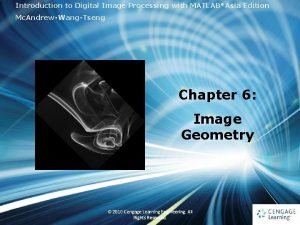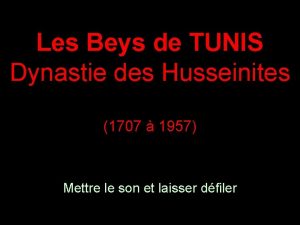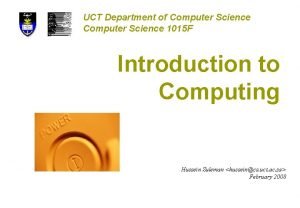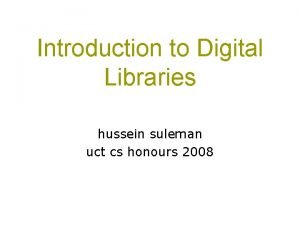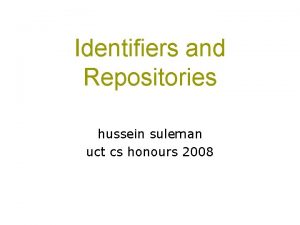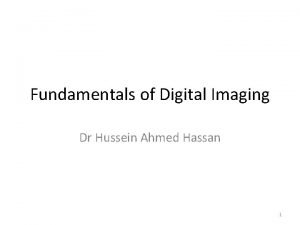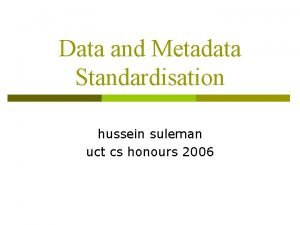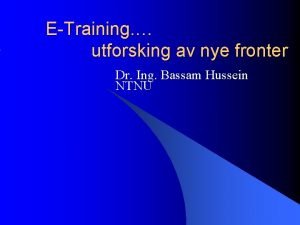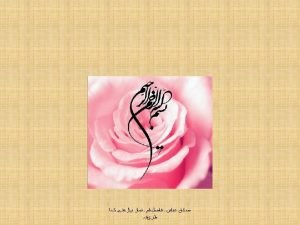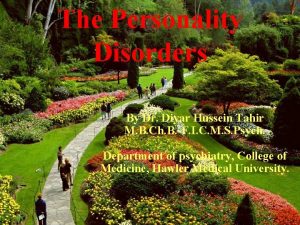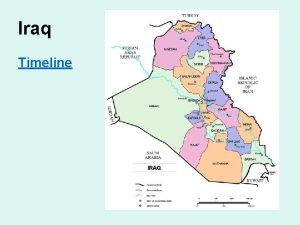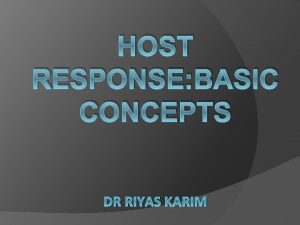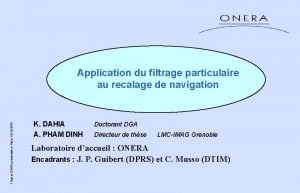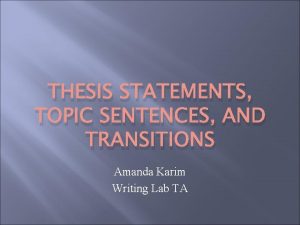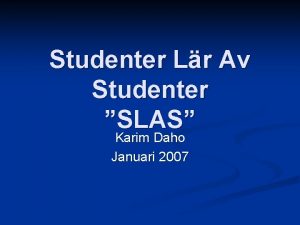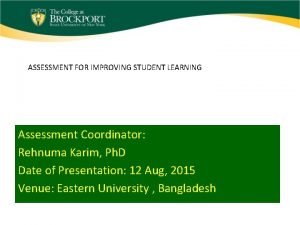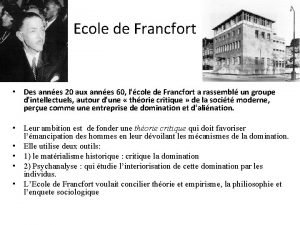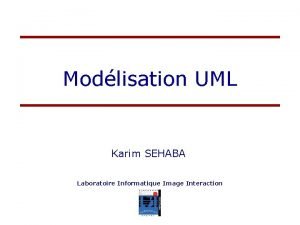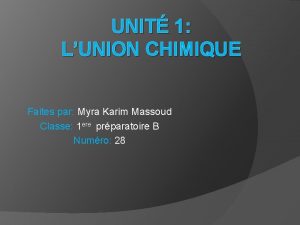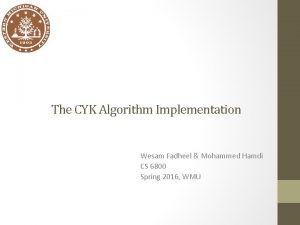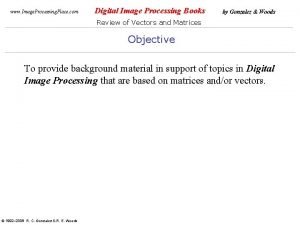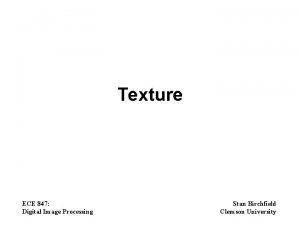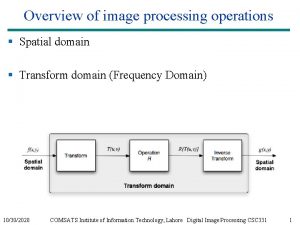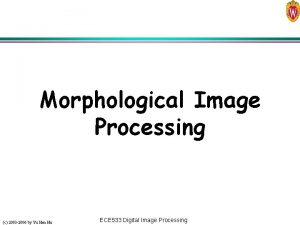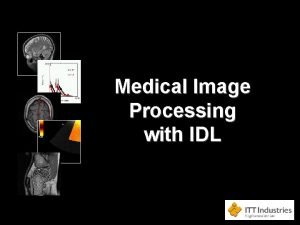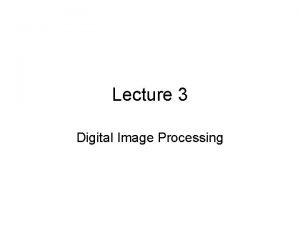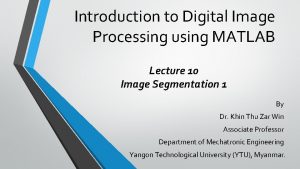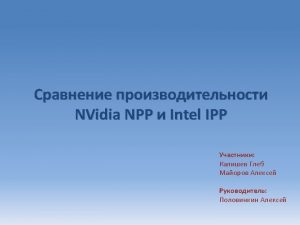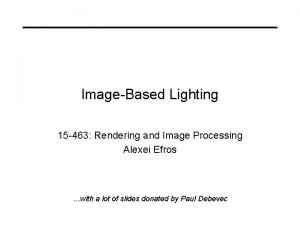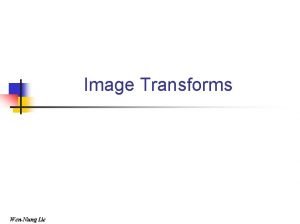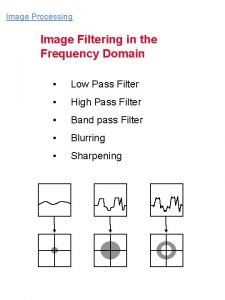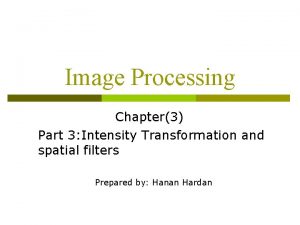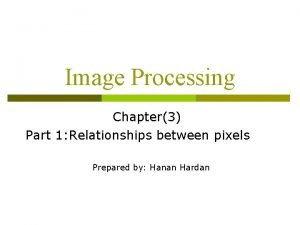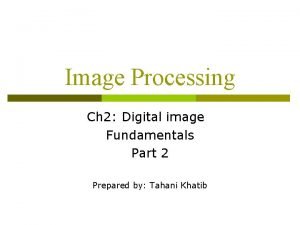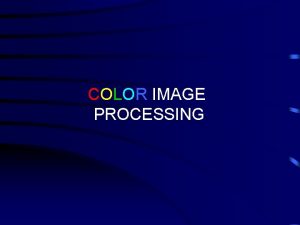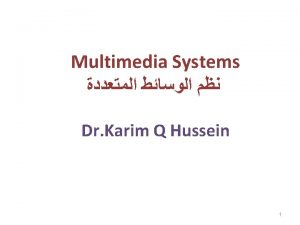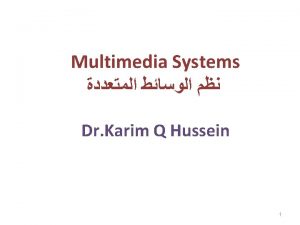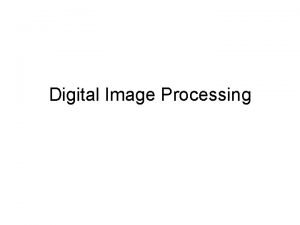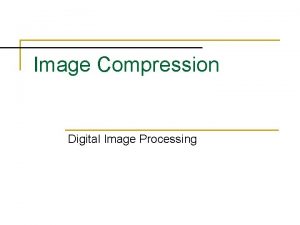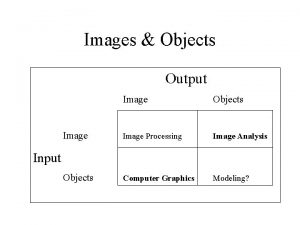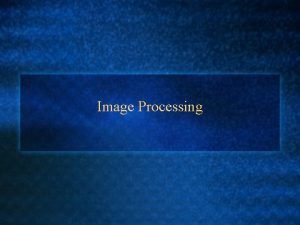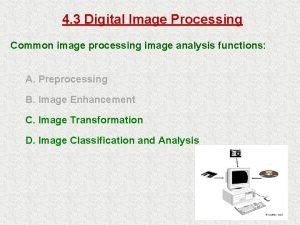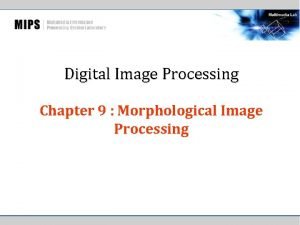Image Processing Dr Karim Q Hussein 1 Introduction



























































































- Slides: 91

Image Processing Dr. Karim Q Hussein 1

Introduction to Computer Vision and Image Processing Computer imaging can be separated into two primary categories: 1. Computer Vision. 2. Image Processing In computer vision application the processed images output for use by a computer, whereas in image processing applications the output images are for human consumption). 2

These two categories are not totally separate and distinct. The boundaries that separate the two are fuzzy, but this definition allows us to explore the differences between the two and to explore the difference between the two and to understand how they fit together Computer Vision 3 Image Processing

Computer Vision Computer vision computer imaging where the application doses not involve a human being in visual loop. One of the major topics within this field of computer vision is image analysis. Image Analysis: involves the examination of the image data to facilitate solving vision problem. Computer vision systems are used in many and various types of environments, such as: Manufacturing Systems , Medical Community, DNA analysis, Satellites Orbiting, Infrared Imaging 4

Image Processing Computer Image processing is computer imaging where application involves a human being in the visual loop. In other words the image are to be examined and a acted upon by people. The major topics within the field of image processing include: Image restoration. Image enhancement. Image compression 5

Image Restoration Is the process of taking an image with some known, or estimated degradation, and restoring it to its original appearance. Image restoration is often used in the field of photography or publishing where an image was somehow degraded but needs to be improved before it can be printed 6

Image Enhancemnet Involves taking an image and improving it visually, typically by taking advantages of human Visual Systems responses. One of the simplest enhancement techniques is to simply stretch the contrast of an image. Enhancement methods tend to be problem specific. For example, a method that is used to enhance satellite images may not suitable for enhancing medical images. Although enhancement and restoration are similar in aim, to make an image look better. They differ in how they approach the problem. Restoration method attempt to model the distortion to the image and reverse the degradation, where enhancement methods use knowledge of the human visual systems responses to improve an image visually. 7

a. image with poor contrast b. Image enhancement by contrast stretching Image Enhancement 8

Image Compression Involves reducing the typically massive amount of data needed to represent an image. This done by eliminating data that are visually unnecessary and by taking advantage of the redundancy that is inherent in most images. Image data can be reduced 10 to 50 times, and motion image data (video) can be reduced by factors of 100 or even 200. 9

a. Image before compression b. Image after compression (92) KB (6. 59)KB Image Compression. 10

Computer Imaging Systems Computer imaging systems are comprised of two primary components types, hardware and software. The hardware components can be divided into image acquiring sub system (computer, scanner, and camera) and display devices (monitor, printer). The software allows us to manipulate the image and perform any desired processing on the image data. 11

Digitization The process of transforming a standard video signal into digital image. This transformation is necessary because the standard video signal in analog (continuous) form and the computer requires a digitized or sampled version of that continuous signal 12

What is a digital image? n We usually operate on digital (discrete) images: q q n n Sample the 2 D space on a regular grid Quantize each sample (round to nearest integer) If our samples are D apart, we can write this as: f[i , j] = Quantize{ f(i D, j D) } The image can now be represented as a matrix of integer values

The image can now be accessed as a two-dimension array of data The digital image is 2 D- array as: I(0, 0) I(0, 1) ……………. . I(0, N-1) I(1, 0) I(1, 1) ……………. . I(1, N-1) ………………………… I(N-1, 0) I(N-1, 1) ……. ……………. . I(N-1, N-1) In image matrix, the image size is (NXN) [matrix dimension] then: Ng= 2 m ………. . (1) Where Ng denotes the number of gray levels m is the no. of bits contains in digital image matrix. Example : If we have (6 bit) in 128 X 128 image. Find the no. of gray levels to represent it , then find the no. of bit in this image? Solution: Ng= 26=64 Gray Level Nb= 128 * 128* 6= 9. 8304 * 104 bit 14

The Human Visual System (HVS) has two primary components: Eye. Brian. * The structure that we know the most about is the image receiving sensors (the human eye). * The brain can be thought as being an information processing unit analogous to the computer in our computer imaging system. These two are connected by the optic nerve, which is really a bundle of nerves that contains the path ways for visual information to travel from the receiving. 15

Image Resolution The resolution has to do with ability to separate two adjacent pixels as being separate, and then we can say that we can resolve the two. The concept of resolution is closely tied to the concepts of spatial frequency. Spatial frequency concept, frequency refers to how rapidly the signal is changing in space, and the signal has two values for brightness-0 and maximum. If we use this signal for one line (row) of an image and then repeat the line down the entire image, we get an image of vertical stripes. If we increase this frequency the strips get closer and closer together, until they finally blend together 16

Image brightness Adaption In image we observe many brightness levels and the vision system can adapt to a wide range. If the mean value of the pixels inside the image is around Zero gray level then the brightness is low and the images dark but for mean value near the 255 then the image is light. If fewer gray levels are bogus ( )ﻣﻨﺤﻨﻲ used, we observe false contours lines resulting from gradually changing light intensity not being accurately represented. 17

Image Representation We have seen that the human visual system (HVS) receives an input image as a collection of spatially distributed light energy; this is form is called an optical image. Optical images are the type we deal with every day –cameras captures them, monitors display them, and we see them [we know that these optical images are represented as video information in the form of analog electrical signals and have seen how these are sampled to generate the digital image I(r , c). The digital image I (r, c) is represented as a two- dimensional array of data, where each pixel value corresponds to the brightness of the image at the point (r, c). in linear algebra terms , a two dimensional array like our image model I( r, c ) is referred to as a matrix , and one row ( or column) is called a vector 18

Binary Image Binary images are the simplest type of images and can take on two values, typically black and white, or ‘ 0’ and ‘ 1’. A binary image is referred to as a 1 bit/pixel image because it takes only 1 binary digit to represent each pixel. These types of images are most frequently in computer vision application where the only information required for the task is general shapes, or outlines information. For an ( ﻳﻤﺴﻚ example, to position a robotics gripper to grasp ( object or in optical character recognition (OCR). Binary images are often created from gray-scale images via a threshold value is turned white (‘ 1’), and those below it are turned black (‘ 0’). 19

Gray Scale Image Gray _scale images are referred to as monochrome, or one-color image. They contain brightness information only, no color information. The number of different brightness level available. The typical image contains 8 bit/ pixel (data, which allows us to have (0 -255) different brightness (gray) levels. The 8 bit representation is typically due to the fact that the byte, which corresponds to 8 -bit of data, is the standard small unit in the world of digital computer. 20

Color Image We Color image can be modeled as three band monochrome image data, where each band of the data corresponds to a different color. . The actual information stored in the digital image data is brightness information in each spectral band. When the image is displayed, the corresponding brightness information is displayed on the screen by picture elements that emit light energy corresponding to that particular color. 21

Multispectral Images Multispectral images typically contain information outside the normal human perceptual range. This may include infrared X-ray, , ( ﺍﻟﺒﻨﻔﺴﺠﻴﻪ ﻓﻮﻕ ultraviolet ( , ( ﺍﻟﺤﻤﺮﺍﺀ (ﺗﺤﺖ acoustic or radar data. Source of these types of image include satellite systems underwater sonar systems and medical diagnostics imaging systems. 22

Overview of Image Properties • An image is composed of an array of dots, more commonly referred to as pixels (short for picture elements). One generally refers to a computer image's dimensions in terms of pixels; this is also often (though slightly imprecisely) known as its resolution. Some common image sizes are 640 × 480, 800 × 600, and 1024 × 768 pixels, which also happen to be common dimensions for computer displays. 23

• In addition to horizontal and vertical dimensions, an image is characterized by depth. The deeper the image, the more colors (or shades of gray) it can have. Pixel depths are measured in bits, the tiniest units of computer storage; - a 1 -bit image can represent two colors (often, though not necessarily, black and white). - a 2 -bit image four colors. - an 8 -bit image 256 colors, and so on. 24

• To calculate the raw size of the image data before any compression takes place, one needs only to know that 8 bits make a byte. • Thus a 320 × 240, 24 -bit image has 76, 800 pixels, each of which is 3 bytes deep, so its total uncompressed size is 230, 400 bytes. 25

1 -bit Images Each pixel is stored as a single bit (0 or 1), so also referred to as binary image. Such an image is also called a 1 -bit monochrome image since it contains no color. Next Figure shows a 1 -bit monochrome image (called “Lena“ by multimedia scientists - this is a standard image used to illustrate many algorithms). 26

27

8 -bit Gray-level Images Each pixel has a gray-value between 0 and 255. Each pixel is represented by a single byte; e. g. , a dark pixel might have a value of 10, and a bright one might be 230. Bitmap: The two-dimensional array of pixel values that represents the graphics/image data. Image resolution: refers to the number of pixels in a digital image (higher resolution always yields better quality). - Fairly high resolution for such an image might be 1600 * 1200, whereas lower resolution might be 640 * 480. 28

Frame Buffer 29

Multimedia Presentation Each pixel is usually stored as a byte (a value between 0 to 255), so a 640 × 480 grayscale image requires 300 k. B of storage (640 × 480 = 307, 200). Next Fig shows the Lena image again, but this time in grayscale. 30

31

Dithering • which is a means of mixing pixels of the available colors together to give the appearance of other colors (though generally at the cost of some sharpness). • When an image is printed, the basic strategy of dithering is used, which trades intensity resolution for spatial resolution to provide ability to print multi-level images on 2 -level (1 bit) printers. 32

An ordered dither consists of turning on the printer output bit for a pixel if the intensity level is greater than the particular matrix element just at that pixel position. Next Fig. (a) shows a grayscale image of "Lena". The ordered-dither version is shown as (b), with a detail of Lena's right eye in (c). 33

34

Color Image Data Types • The most common data types for graphics and image file formats ; 24 -bit color and 8 -bit color. • Some formats are restricted to particular hardware/operating system platforms, while others are “cross-platform” formats. • Even if some formats are not cross-platform, there are conversion applications that will recognize and translate formats from one system to another. • Most image formats incorporate some variation of compression technique due to the large storage size of image files. Compression techniques can be classified into either lossless or lossy. 35

8 -bit Color Images Many systems can make use of 8 bits of color information (the so-called “ 256 colors”) in producing a screen image. Such image files use the concept of a lookup table to store color information. - Basically, the image stores not color, but instead just a set of bytes, each of which is actually an index into a table with 3 -byte values that specify the color for a pixel with that lookup table index. 36

Color Look-up Tables (LUTs) The idea used in 8 -bit color images is to store only the index, or code value, for each pixel. Then, e. g. , if a pixel stores the value 25, the meaning is to go to row 25 in a color look-up table (LUT). 37

38

24 -bit Color Images • In a color 24 -bit image, each pixel is represented by three bytes, usually representing RGB. - This format supports 256* 256 possible combined colors, or a total of 16, 777, 216 possible colors. - However such flexibility does result in a storage penalty: A 640*480 24 -bit color image would require 921. 6 k. B of storage without any compression. • Full-color photographs may contain an almost infinite range of color values. Dithering is the most common means of reducing the color range of images down to the 256 (or fewer) colors seen in 8 -bit GIF images. 39

Chapter Two Image Analysis 40

Image Analysis Image analysis involves manipulating the image data to determine exactly the information necessary to help solve a computer imaging problem. This analysis is typically part of a larger process, is iterative in nature and allows us to answer application specific equations: Do we need color information? Do we need to transform the image data into the frequency domain? Do we need to segment the image to find object information? What are the important features of the image? Image analysis is primarily data reduction process. As we have seen, images contain enormous amount of data, typically on the order hundreds of kilobytes or even megabytes. Often much of this information is not necessary to solve a specific computer imaging problem, so primary part of the image analysis task is to determine exactly what information is necessary. Image analysis is used both computer vision and image processing. But it is different. 41

System Model The image analysis process can be broken down into three primary stages: 1 - Preprocessing. 2 - Data Reduction. 3 - Features Analysis. Preprocessing: Is used to remove noise and eliminate irrelevant, visually unnecessary information. Noise is unwanted information that can result from the image acquisition process, other preprocessing steps might include: -Gray –level or spatial quantization (reducing the number of bits per pixel or the image size). -Finding regions of interest for further processing. 42

Data Reduction Involves either reducing the data in the spatial domain or transforming it into another domain called the frequency domain, and then extraction features for the analysis process. 43

Features Analysis The features extracted by the data reduction process are examine and evaluated for their use in the application. After preprocessing we can perform segmentation on the image in the spatial domain or convert it into the frequency domain via a mathematical transform. After these processes we may choose to filter the image. This filtering process further reduces the data and allows us to extract the feature that we may require for analysis. 44

Preprocessing preprocessing algorithm, techniques and operators are use to perform initial processing that makes the primary data reduction and analysis task easier. They include operations related to: -Extracting regions of interest. -Performing basic algebraic operation on image. -Enhancing specific image features. -Reducing data in resolution and brightness. Preprocessing is a stage where the requirements are typically obvious and simple, such as removal of artifacts from images or eliminating of image information that is not required for the application. For example, in one application we needed to eliminate borders from the images that have been digitized from film. Another example of preprocessing step involves a robotics gripper that needs to pick and place an object ; for this we reduce a gray-level image to binary (twovalued) image that contains all the information necessary to discern the object ‘s outlines. 45

Region –of-Interest Image Geometry Often, for image analysis we want to investigate more closely a specific area within the image, called region of interest (ROI). To do this we need operation that modifies the spatial coordinates of the image, and these are categorized as image geometry operations. The image geometry operations discussed here include: Zoom, enlarge , shrink, translate and rotate. , ( ﺑﺮﻭﺯ Crop ( The image crop process is the process of selecting a small portion of the image, a sub image and cutting it away from the rest of the image. After we have cropped a sub image from the original image we can zoom in on it by enlarge it. The zoom process can be done in numerous ways: 1 - Zero-Order Hold. 2 - First _Order Hold. 3 - Convolution. 46

Zero-Order hold is performed by repeating previous pixel values, thus creating a blocky effect as in the following figure: 47

First _Order Hold is performed by finding linear interpolation between a adjacent pixels, i. e. , finding the average value between two pixels and use that as the pixel value between those two, we can do this for the rows first as follows 48

49

First _Order Hold Method 50

Convolution this process requires a mathematical process to enlarge an image. This method required two steps: 1 - Extend the image by adding rows and columns of zeros between the existing rows and columns 2 - Perform the convolution 51

52

The convolution process requires us to overlay the mask on the values and sum all these results. ( )ﻣﺘﻘﺎﺑﻠﻪ image, multiply the coincident This is equivalent to finding the vector inner product of the mask with underlying sub image. The vector inner product is found by overlaying mask on sub image. Multiplying coincident terms, and summing the resulting products For example, if we put the mask over the upper-left corner of the image, we obtain (from right to left, and top to bottom) : 1/4(0) +1/2(0) +1(3) +1/2(0) + 1/4(0) +1/2(0) +1/4(0) =3 Note that the existing image values do not change. The next step is to slide the mask over by on pixel and repeat the process, as follows: 1/4(0) +1/2(0) +1/4(0) +1/2(3) +1(0) +1/2(5) + 1/4(0) +1/2(0) +1/4(0) =4 Note this is the average of the two existing neighbors. This process continues until we get to the end of the row, each time placing the result of the operation in location corresponding to center of mask. When the end of the row is reached, the mask is moved down one row, and the process is repeated row by row. This procedure has been performed on the entire image, the process of sliding, multiplying and summing is called convolution. . 53

54

what if we want to enlarge an image by something other than a factor of (2 N-1)? To do this we need to apply a more general method. We take two adjacent values and linearly interpolate more than one value between them. This is done by define an enlargement number k and then following this process: 1 - Subtract the result by k. 2 - Divide the result by k. 3 - Add the result to the smaller value, and keep adding the result from the second step in a running total until all (k-1) intermediate pixel locations are filled. 55

Example: we want to enlarge an image to three times its original size, and we have two adjacent pixel values 125 and 140. Find the difference between the two values, 140 -125 =15. The desired enlargement is k=3, so we get 15/3=5. next determine how many intermediate pixel values. we need : K-1=3 -1=2. The two pixel values between the 125 and 140 are 125+5=130 and 125+2*5 = 135. We do this for every pair of adjacent pixels. first along the rows and then along the columns. This will allows us to enlarge the image by any factor of K (N-1) +1 where K is an integer and N×N is the image size. To process opposite to enlarging an image is shrinking. This process is done by reducing the amount of data that need to be processed. Two other operations of interest image geometry are: Translation and Rotation. These processes may be performed for many application specific reasons, for example to align an image with a known template in pattern matching process or make certain image details easer to see. 56

Example of Enlarge image 5 times Example: Given an image has two adjacent pixel values of 210 and 240. Enlarge the image five times. 1. 240 -210 = 30 ( differences of color value between the two adjacent pixels) 2. K = 5 ---- 30/5 = 6 3. K-1 = 5 -1 = 4 4. K = 1 - 210 + 6*1 = 216 5. K = 2 - 210 + 6*2 = 222 6. K=3 - 210 + 6*3 = 228 7. K= 4 - 210 + 6* 4 = 234 57

Ch 2, lesson 2: Zooming and shrinking Nearest neighbor interpolation Example: Suppose A 2 x 2 pixels image will be enlarged 2 times by the nearest neighbor method: 1. Lay an imaginary 4*4 grid over the original image. . 2. For any point in the overlay, look for the closest pixel in the original image, and assign its gray level to the new pixel in the grid. (copy) 3. When all the new pixels are assigned values, expand the overlay grid to the original specified size to obtain the zoomed image. • Pixel replication (re sampling) is a special case that is applicable when the size of the image needs to be increased an integer number of times (like 2 times not 1. 5 for example). + ve : Nearest neighbor is fast -ve: it produces a checkerboard effect like this! 58

Image Algebra There are two primary categories of algebraic operations applied to image: 1 - Arithmetic operations. 2 - Logic operations Addition, subtraction, division and multiplications comprise the arithmetic operations, while AND, OR and NOT makeup the logic operations. These operations which require only one image, and are done on a pixel –by-pixel basis. 59

60

Subtraction of two images is often used to detect motion consider the case where nothing has changed in a sense; the image resulting from subtraction of two sequential image is filled with zero-a black image. If something has moved in the scene, subtraction produces a nonzero result at the location of movement. Applications include Object tracking , Medical imaging, Law enforcement and Military applications Multiplication and Division are used to adjust the brightness of an image. One image typically consists of a constant number greater than one. Multiplication of the pixel values by a number greater than one will darken the image (Brightness adjustment is often used as a processing step in image enhancement). 61

62

a. Original image b. Image divided by value<1 Image Division. 63 c. Image divided by value >1

Logic operations logic operations AND, OR and NOT form a complete set, meaning that any other logic operation (XOR, NAND) can be created by a combination of these basic elements. They operate in a bit-wise fashion on pixel data. 64

Example: A logic AND is performed on two images, suppose the two corresponding pixel values are (111)10 is one image and (88)10 in the second image. The corresponding bit strings are: (111)10 011011112 (88)10 010110002 AND ------------- 01001000 The logic operation AND and OR are used to combine the information in two images. They may be done for special effects, but a more useful application for image analysis is to perform a masking operation. Use AND and OR as a simple method to extract a Region of Interest from an image, if more sophisticated graphical methods are not available. 65

Example: A white square ANDed with an image will allow only the portion of the image coincident with the square to appear in the output image with the background turned black; and a black square ORd with an image will allow only the part of the image corresponding to the black square to in the output image but will turn the rest of the image white. This process is called image masking. The NOT operation creates a negative of the original image, by inverting each bit within each pixel value. 66

A. Original image b. Image mask (AND))) c. ANDing a and b d. Image mask (OR) e. ORing a and d Image masking Complement Image a. Original image 67 b. Image after NOT operation.

Image Restoration: Image restoration methods are • used to improve the appearance of an image by application of a restoration process that use mathematical model for image degradation. Example of the type of degradation: • 1 - Blurring caused by motion or atmospheric • disturbance. 2 - Geometrics distortion caused by imperfect • lenses. 3 - Superimposed interface patterns caused by • mechanical systems. 4 - Noise from electronic source • 68

What is noise? Noise is any undesired information that contaminates an image. Noise appears in image from a variety of source. The digital image a acquisition process, which converts an optical image into a continuous electrical signal that is then sampled is the primary process by which noise appears in digital images. ( ﺗﺬﺑﺬﺏ At every step in the process there are fluctuations ( that add a random ( ﻇﺎﻫﺮﻩ caused by natural phenomena ( value to exact brightness value for a given pixel. In typical image the noise can be modeled with one of the following distribution: 1 - Gaussian (“normal”) distribution. 2 - Uniform distribution. 69 3 - Salt _and _pepper distribution.

Image Noise. 70

Noise Removal using Spatial Filters Spatial filtering is typically done for: Remove various types of noise in digital images. Perform some type of image enhancement. [These filters are called spatial filter to distinguish them from frequency domain filter]. The three types of filters are: Mean filters Median filters (order filter) Enhancement filters 71

Mean and median filters are used primarily to conceal or remove noise, although they may also be used for special applications. For instance, a mean filter adds “softer” look to an image. The enhancement filter high lights edges and details within the image. Spatial filters are implemented with convolution masks. Because convolution mask operation provides a result that is weighted sum of the values of a pixel and its neighbors, it is called a linear filter. 72

Image Enhancement & Restoration Enhancement techniques are employed • essentially to get better quality picture and not necessarily the original object from the degraded scene like Restoration techniques. 73

Image Enhancement & Restoration • Spatial image enhancement techniques (noise reduction) – Spatial low-pass, high-pass & band-pass filtering – Unsharp masking & crisping – Directional smoothing – Median filtering 74

Arithmetic mean filter smoothing or low-pass filter. 1⁄9 1⁄9 1⁄9 75

76

The median filter is a non linear filter (order filter). These filters are based on as specific type of image statistics called order statistics. Typically, these filters operate on small sub image, “Window”, and replace the centre pixel value (similar to the convolution process). Order statistics is a technique that arranges the entire pixel in sequential order, given an NXN window (W) the pixel values can be ordered from smallest to the largest. I 1 ≤ I 2 ≤ I 3. . . …………………< IN Where I 1, I 2, I 3. . . ……, IN are the intensity values of the subset of pixels in the image 77

a. Salt and pepper noise b. Median filtered image (3 x 3) 78

Example of Median Filter Example: Given the following 3 X 3 neighborhood 5 5 6 3 4 5 3 4 7 We first sort the value in order of size (3, 3, 4, 4, 5, 5, 5, 6, 7) ; then we select the middle value , in this case it is 5. This 5 is then placed in centre location. A median filter can use a neighbourhood of any size, but 3 X 3, 5 X 5 and 7 X 7 are typical. Note that the output image must be written to a separate image (a buffer); so that the results are not corrupted as this process is performed. (The median filtering operation is performed on an image by applying the sliding window concepts, similar to what is done with convolution). The window is overlaid on the upper left corner of the image, and the median is determined. This value is put into the output image (buffer) corresponding to the centre location of the window. The window is then slide one pixel over, and the process is repeated. 79

Note that the outer rows and columns are not replaced. In practice this is usually not a problem due to the fact that the images are much larger than the masks. And these “wasted” rows and columns are often filled with zeros (or cropped off the image). For example, with 3 X 3 mask, we lose one outer row and column, a 5 X 5 mask we lose two rows and columns. This is not visually significant for a typical 256 X 256 or 512 X 512 images. The maximum and minimum filters are two order filters that can be used for elimination of salt- and-pepper noise. The maximum filter selects the largest value within an ordered window of pixels values; where as the minimum filter selects the smallest value. 80

In a manner similar to the median, minimum and maximum filter, order filter can be defined to select a specific pixel rank within the ordered set. For example we may find for certain type of pepper noise that selecting the second highest values works better than selecting the maximum value. This type of ordered selection is very sensitive to their type of images and their use it is application specific. It should note that, in general a minimum or low rank filter will tend to darken an image and a maximum or high rank filter will tend to brighten an image. 81

The Enhancement filter 1 - Laplacian type. • 2 - Difference filter. • These filters will tend to bring out, or enhance details in the image. • Example of convolution masks for the Laplacian-type filters are: • 0 -1 -1 -2 1 -2 -1 5 -1 9 -1 1 5 1 0 -1 0 -1 -1 -2 1 -2 The Laplacian type filters will enhance details in all directions equally. • 82 Original Laplacian

Example : Describe the effects of High pass filter on the image ? 30 3 30 Sol 30(0) + 3(-1) + 30(5) + 3(-1) + 3(0) + 3(-1) + 30(0) = 0 - 3 + 150 – 3 + 0 - 3 + 0 = -12 + 150 = 138 83

Image quantization is the process of reducing the image data • by removing some of the detail information by mapping group of data points to a single point. This can be done by: Gray_Level reduction (reduce pixel values themselves I(r, c). • Spatial reduction (reduce the spatial coordinate (r, c). • The simplest method of gray-level reduction is Thresholding. • We select a threshold gray _level and set everything above that value equal to “ 1” and everything below the threshold equal to “ 0”. This effectively turns a gray_level image into a binary (two level) image and is often used as a preprocessing step in the extraction of object features, such as shape, area, or parameter 84

Image quantization Cont. A more versatile method of gray _level reduction is the • process of taking the data and reducing the number of bits per pixel. This can be done very efficiency by masking the lower bits via an AND operation. Within this method, the numbers of bits that are masked determine the number of gray levels available. Example: • We want to reduce 8_bit information containing 256 • possible gray_level values down to 32 possible values. This can be done by ANDing each 8 -bit value with the bit • string 1111000. this is equivalent to dividing by eight(23), corresponding to the lower three bits that we are masking and then shifting the result left three times. [Gray _level in the image 0 -7 are mapped to 0, gray_level in the range 8 -15 are mapped to 8 and so on]. 85

Edge Detection Detecting edges is a basic operation in image processing. The edges of items in an image hold much of the information in the image. The edges tell you where: Items are. Their size. shape and something about their texture. Edge detection methods are used as a first step in the line detection processes, and they are used to find object boundaries by marking potential edge points corresponding to place in an image where rapid changes in brightness occur. After these edge points have been marked, they can be merged to form lines and objects outlines 86

Edge Detection Cont. 1 - Sobel Operator: The Sobel edge detection masks look for edges in both the horizontal and vertical directions and then combine this information into a single metric. The masks are as follows: Row Mask. Column Mask -1 -2 -1 0 1 0 0 -2 0 2 1 -1 0 1 These masks are each convolved with the image. At each pixel location we now have two numbers: S 1, corresponding to the result form the row mask and S 2, from the column mask. We use this numbers to compute two matrices, the edge magnitude and the edge direction, which are defined as follows: Edge Magnitude= S 1ˆ2 + S 2 ˆ2 Edge Direction = Tan -1 87 S 1 S 2

EXAMPLE Sobel Filter Ex. decribe the effects of Laplace and Sobel filters on the image? 10 20 200 10 200 Solution : 1 - Laplace 0 -1 0 -1 4 -1 0 -1 0 = 10(0) + 20(-1) +200(0) + 10(-1) + 20(4) + 200(-1) + + 10(0) + 20(-1) + 200(0) = -170 2 - Sobel Mask(row) -1 -2 -1 Mask (column) -1 0 1 0 0 0 -2 0 2 1 2 1 1 2 1 S 1 = 10(-1) + 20(-2) +200(-1) + 10(0) + 200(0) +10(1)+20(2) +200(1) = 0 S 2 = 10(-1) +20(0) +200(1)+10(-2)+20(0)+200(2) +10(-1)+20(0)+200(1) 88 = 760

Edge Detection Cont. : Edge Magnitude= S 1ˆ2 + S 2 ˆ2 0 ˆ2 + 760 ˆ2 = = 760 Edge Direction = Tan -1 S 2 0 7600 = tan-1(0) 89 S 1

Laplacian Operators The Laplacian operator described here are similar to the ones used for pre-processing (as described in enhancement filter). The three Laplacian masks that follow represent different approximation of the Laplacian masks are rationally symmetric, which means edges at all orientation contribute to the result. They are applied by selecting one mask and convolving it with the image. 90

Laplacian Operators Cont. 0 -1 0 1 -2 1 -1 -1 -1 4 -1 -2 4 -2 -1 8 -1 0 -1 0 1 -2 1 -1 -1 -1 These masks differ from the Laplacian type previously described in that the centre coefficients have been decreased by one. So, if we are only interested in edge information, the sum of the coefficients should be zero. If we want to retain most of the information the coefficient should sum to a number greater than zero. Consider an extreme example in which the center coefficient value will depend most heavily up on the current value, with only minimal contribution from surrounding pixel values. 91
 Unsharp masking matlab
Unsharp masking matlab Image enhancement point processing techniques
Image enhancement point processing techniques Histogram processing in digital image processing
Histogram processing in digital image processing Neighborhood processing in digital image processing
Neighborhood processing in digital image processing پردازش تصویر
پردازش تصویر Morphological
Morphological Image transform in digital image processing
Image transform in digital image processing Noise
Noise Compression models in digital image processing
Compression models in digital image processing Key stages in digital image processing
Key stages in digital image processing Lossless image compression matlab source code
Lossless image compression matlab source code Image sharpening and restoration
Image sharpening and restoration Image geometry in digital image processing
Image geometry in digital image processing Isopreference curve
Isopreference curve Image transform in digital image processing
Image transform in digital image processing Imtransform matlab
Imtransform matlab Image restoration in digital image processing
Image restoration in digital image processing Oerdigital
Oerdigital Introduction to digital image processing with matlab
Introduction to digital image processing with matlab Karen hussein
Karen hussein Hassine bey
Hassine bey Taha hussein challenges
Taha hussein challenges Laila hussein
Laila hussein Alex hoffer stanford
Alex hoffer stanford Uct computer
Uct computer Hussein suleman
Hussein suleman Hussein suleman
Hussein suleman Reporaproblem
Reporaproblem Dr. hussein shaqra
Dr. hussein shaqra Mbbsch
Mbbsch Hussein suleman
Hussein suleman Bassam hussein
Bassam hussein Bismillahir rahmanir rahim alhamdulillahi rabbil alamin
Bismillahir rahmanir rahim alhamdulillahi rabbil alamin Audrey sedal
Audrey sedal Emptiness
Emptiness Bleibel
Bleibel Ananda sabil hussein
Ananda sabil hussein Saddam hussein
Saddam hussein Saddam hussein
Saddam hussein Alma hussein 28
Alma hussein 28 Mbbsch
Mbbsch Saddam hussein
Saddam hussein Dr hussein saad
Dr hussein saad George bush apush
George bush apush Nadya hussein
Nadya hussein Evelin karim aziz
Evelin karim aziz Karim benali
Karim benali Riyas karim
Riyas karim Al karim artinya
Al karim artinya Karim dahia
Karim dahia Topic sentence and thesis statement
Topic sentence and thesis statement Karim daho
Karim daho Yazan karim
Yazan karim Yazan karim
Yazan karim Rehnuma karim
Rehnuma karim Kehujjahan mazhab shahabi
Kehujjahan mazhab shahabi Karim emile bitar
Karim emile bitar Dr karim aref
Dr karim aref Dr azmat karim
Dr azmat karim Uml image
Uml image Prof. dr. karim fereidooni herkunft
Prof. dr. karim fereidooni herkunft Keistimewaan alquran
Keistimewaan alquran Karim massoud
Karim massoud Dr adiwarman karim
Dr adiwarman karim Cyk algorithm step by step
Cyk algorithm step by step Meneladani asmaul husna al karim
Meneladani asmaul husna al karim Top-down vs bottom-up processing
Top-down vs bottom-up processing Gloria suarez
Gloria suarez Bottom-up processing examples
Bottom-up processing examples Primary and secondary food processing
Primary and secondary food processing Parallel processing vs concurrent processing
Parallel processing vs concurrent processing Top down vs bottom up processing
Top down vs bottom up processing Batch processing and interactive processing
Batch processing and interactive processing Image processing place.com
Image processing place.com Image processing and analysis stan birchfield pdf
Image processing and analysis stan birchfield pdf How to shrink a rubber band
How to shrink a rubber band Region filling process has appliction in
Region filling process has appliction in Spatial operations in image processing
Spatial operations in image processing Opening image processing
Opening image processing Idl fft
Idl fft Aliasing in digital image processing
Aliasing in digital image processing Representation and description in digital image processing
Representation and description in digital image processing Computer vision vs image processing
Computer vision vs image processing Threshold image matlab
Threshold image matlab Ipp image processing
Ipp image processing Renender
Renender Kl transform example
Kl transform example Frequency domain image
Frequency domain image Intensity slicing in image processing
Intensity slicing in image processing Explain basic relationship between pixels
Explain basic relationship between pixels Intensity transformations and spatial filtering
Intensity transformations and spatial filtering Zooming and shrinking in digital image processing
Zooming and shrinking in digital image processing


















